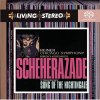How a recording presents a solid and deep soundstage in a room depends mostly on the microphone technique used. Using three spaced omni-directional microphones such as this recording, there is a
very delicate balance between an even spread of sound across the soundstage and having a hole-in-the-middle where the sound bunches up toward the left and right side. Using three discrete channels overcomes this tendency if done well. However if a derived 3-to-2 mix is well done,
and the speakers are not influenced by the room to any large degree, there should be no real difference in a pure 3 channel presentation and a derived stereo mix of the 3 channel master; the onus is on the speakers/room. Horns which are very directional by nature help tremendously in this regard, since they're almost like using headphones in that the room influence is much less.
Most classical recordings made in America use spaced omni-directional mics, where European recordings tend to use the Blumlien or ORTF techniques. The Blumlien and ORTF are
specfically stereo techniques; omni-directional microphones are somewhat ill-suited to stereo, and thus more reliant on the center channel,
or very careful balancing of the mixdown and especially the speakers/room.
In any event, while this is a good recording, it isn't necessarily the best; my original comments were mainly regarding the musical performance, which is remarkable.
My reference disc for great stereo imaging and soundstage goes to this recording - at least with my speakers and my room (YMMV);
https://www.amazon.com/Ralph-Vaughan-Williams-Masque-Dancing/dp/B00000DO12/ref=sr_1_1?s=music&ie=UTF8&qid=1525209232&sr=1-1&keywords=Vernon+Handley,+Job
Playing track #4 (Scene IV), the depth of the stage is staggering with the instruments in proper width and depth relationship. The boundaries of the recording stage can clearly be heard side to side and front to back. I wish all recordings sounded this good.




 Sigh... too many albums to remember. Oh well at least it wasn't overly expensive. Anyone want it? I'll sell it cheap; don't care so much about the money but someone else should enjoy this extra copy.
Sigh... too many albums to remember. Oh well at least it wasn't overly expensive. Anyone want it? I'll sell it cheap; don't care so much about the money but someone else should enjoy this extra copy.